skip to main |
skip to sidebar
Events of Saturday 21st June 2014
I'm not very familiar with the North West Coast of England although, over the years, I've made various visits. On the Longest Day in 2014, with the prospect of good weather, I decided to make a one-day trip by rail at least as far as Barrow-in-Furness and, possibly, beyond. I made an early start from home allowing me to catch the 06:37 Virgin 'Pendolino' service to Edinburgh which deposited me at Lancaster station in about 90 minutes.
Lancaster
From a railway point of view, Lancaster is the gateway to Furness and the Cumbrian Coast, if you are travelling from the south. The station is an imposing structure in stone which I briefly described in the earlier post Return to Heysham.
I had a little time to wait before the next onward service to Barrow-in-Furness, which gave me an opportunity to explore on foot the area around Lancaster Castle and the Priory Church of St Mary (which they confusingly now refer to as 'Lancaster Priory'). The Castle, of course, is built on a hill offering splendid views in various directions. It was a perfect morning, warming up nicely but still with a haze over the hills. Looking seawards, the two nuclear Power Stations at Heysham (described in Return to Heysham) were clearly visible. In another direction, the rooftops of the town were spread out, with attractive stone-built houses meandering down the hill from the Castle.
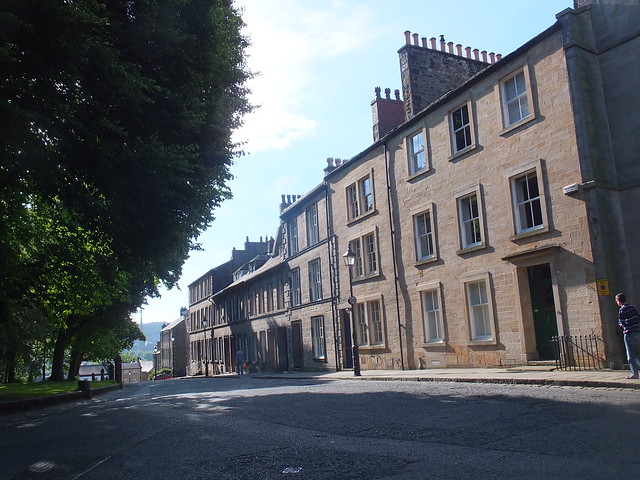 "...attractive stone-built houses meandering down the hill..."
"...attractive stone-built houses meandering down the hill..."
I descended the steep footpath past the site of the Roman Bath House (which I skipped on this brief visit) to the Town Quay on the River Lune. The Lune Millennium Bridge crosses the river here - a curving pedestrian bridge in a very modern style, cable-stayed from two massive pylons.
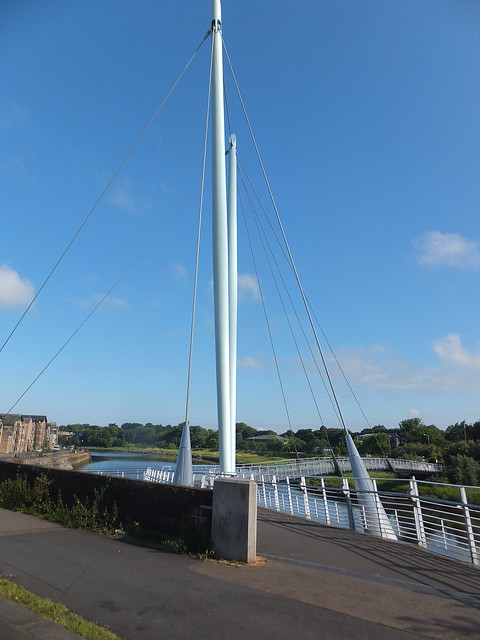
The Lune Millennium Bridge.
A little upstream, there was already plenty of traffic on the road bridge across the river. The 'Greyhound Bridge' had originally carried the former Midland railway line from Lancaster Green Ayre to Morecambe but, when the line was abandoned, the bridge was retained and converted for road traffic. I returned up the steep hill to the station and caught the slightly-delayed 09:02 stopping train to Barrow-in-Furness.
Carnforth and beyond
Our first station stop was at Carnforth. This was where many of the location scenes for the 1945 film 'Brief Encounter' were shot and the station still draws visitors because of that association, in fact, it has its own Heritage Centre and Refreshment Room. There's an interesting commentary on the film's continuing attraction on the 'Guardian' site here.
My train carried on, making brief stops at Silverdale, Arnside and Grange-Over-Sands (where the station is next to the sea front and a broad footpath extending along the coast encourages walkers). We continued, stopping at Kents Bank, Cark, Ulverston (with its rather elegant station buildings, featuring a tall clock tower), Dalton and Roose.
Barrow-in-Furness
As we approached Barrow, the broad, now apparently unused, expanse of Cavendish Dock appeared on our left. Beyond, there were signs of activity in Ramsden Dock with a couple of cargo ships. The port of Barrow is one of 21 operated by ABP (Associated British Ports) in Great Britain. There's a brief summary of Barrow's port facilities here and a plan of the port here. I believe there are still occasional trains from Ramsden Dock to the processing plant at Sellafield, carrying nuclear waste from nuclear power stations in Japan and the Netherlands for treatment.
Soon, my train was passing between rows of houses of a typical industrial town and stopping at Barrow, where I alighted, intending to spend about an hour looking around the town before continuing north on a later train. After Carlisle, Barrow is the second largest population centre in Cumbria with a present population of around 70,000.
I knew that the discovery of iron ore in Cumbria, together with coal, triggered the ironmaking and steelmaking industry in Barrow. I didn't realise that, around 1900, Barrow had the largest steelworks in the world, operated by the Barrow Hematite Steel Company Limited. Local iron ore deposits became exhausted in 1963 and steelmaking finally ceased in 1980.
Shipbuilding started in Barrow in 1871 but I didn't know that around 700 vessels had been built - there's a Wikipedia list here. Submarines are still constructed in Barrow by BAe Systems, see Wikipedia article. Shipbuilding now takes place under cover in the huge Devonshire Dock Hall (DDH). There's no traditional launch slipway - vessels are lowered into the water on a huge shiplift which can handle 24,300 tonnes!
For more information on Barrow, see the Wikipedia article.
Barrow-in-Furness railway station is modern but houses the original memorial to railwaymen who lost their lives in the Great War. The memorial shows obvious signs of damage - a small sign added below the memorial explains "THE DAMAGE TO THIS MEMORIAL WAS CAUSED BY ENEMY ACTION IN WORLD WAR II 1939-1945."

Click for larger size.
The War Memorial at Barrow-in-Furness railway station.
I quickly realised that Barrow's steelworks and shipbuilding yard had made the town an important target for the Luftwaffe in World War II. I learned afterwards that, in a series of air raids in 1941, 83 people in Barrow were killed and hundreds injured. There's a Wikipedia article on the Barrow Blitz.
I set off on foot towards the centre of the town, aiming for the sandstone clocktower of the tallest building around, which turned out to be the neo-Gothic Town Hall, completed in 1886. Although I passed a number of new buildings (the Courts, a modern shopping area including Debenhams and The Forum Entertainment Centre), sufficient older buildings remained to leave a sense of identity. A number of streets had been pedestrianised, which helps to give a human scale so I quite enjoyed my perambulation.
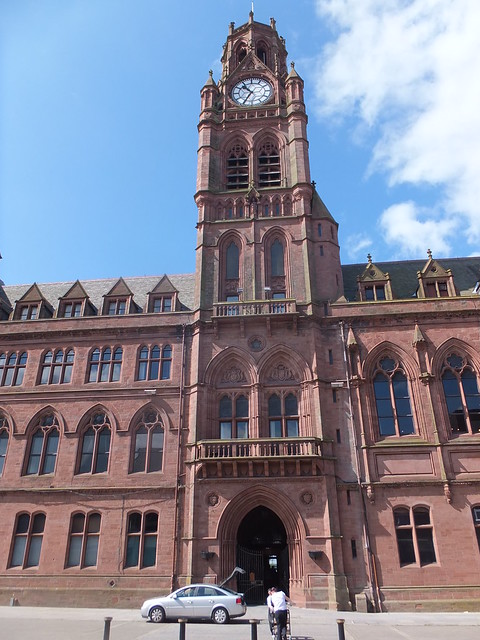
Barrow-in-Furness Town Hall.
One long area of water pierces through the town: this is Buccleuch Dock on the seaward end (including the Town Quay which berths two superannuated ships one of which served as the 'Blue Lagoon Night Club' until 2010) and Devonshire Dock at the landward end (terminated in the massive Devonshire Dock Hall mentioned above). The bridge carrying Michaelson Road divides the two docks.
 BAe System's covered shipbuilding hall at the end of Devonshire Dock, with the Shiplift visible outside the doors.
BAe System's covered shipbuilding hall at the end of Devonshire Dock, with the Shiplift visible outside the doors.
I retraced my route back to the station in time to catch the next northbound train.
Beyond Barrow
I joined the 11:22 to Whitehaven which had earlier come from Carlisle along what's presently marketed as 'The Cumbria Line' and was timed to arrive in bay platform 3 at Barrow at 11:08. Around the same time, the 09:45 from Preston was due in Platform 1 at 11:04, then returning to Lancaster at 11:20.
My train was allowed 77 minutes for the 46 mile journey to Whitehaven with a number of stops on the way. Some of these stations were request stops - tell the Guard if you want to get off, handsignal the approaching train if you want to get on. I don't remember 'missing out' any of the stops - it was a summer Saturday and there were plenty of passengers. In the following station list, the request stops are marked with an (x).
Askam
Kirkby-in-Furness (x)
Foxfield (x)
Green Road (x)
Millom
Silecroft (x)
Bootle (x)
Ravenglass
Drigg (x)
Seascale
Sellafield
Braystones (x)
Nethertown (x)
St. Bees
Corkickle (x)
The railway continues to rely upon largely traditional operating methods with mainly semaphore signals, frequent signal boxes and even more frequent level crossings of various styles - User Worked, Manual Gates, the occasional Automatic Barrier.
With excellent weather, the appeal of the area was obvious - on our right the mountains, on our left either low, rocky embankments dividing the railway from the sea or fields with grazing cows reaching to the sea shore. There did seem to be rather a lot of wind turbines but, I afterwards discovered, this is Britain's Energy Coast with the Mission Statement "To lead the transition of West Cumbria into an economy that will flourish in a low carbon future."
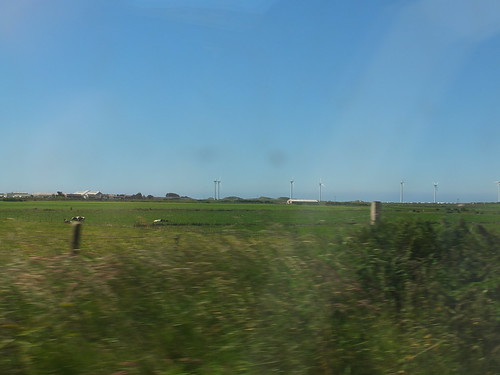 Green fields, cattle grazing ... and windfarms.
Green fields, cattle grazing ... and windfarms.
Ravenglass is a widely-known station, because a short walk leads to the terminus of the famous 'Ratty' - the Ravenglass and Eskdale 15-inch gauge steam railway which extends seven miles to Dalegarth.
About one and a half miles beyond Ravenglass, we stopped at Drigg station, with its signal box, manually-worked crossing gates and a siding trailing off on the Down side into an anonymous-looking well-fenced area. This remote area opened in 1940 as a wartime Royal Ordnance Factory for the manufacture of TNT explosive.
The next station is at Seascale - an almost-perfect seaside village with a population of around 1800. I say 'almost' because, as the picture below shows, around one mile north of the village is the industrial complex now known as Sellafield.
 Aerial view of Seascale with Sellafield in the background (Photo: Visit Cumbria).
Aerial view of Seascale with Sellafield in the background (Photo: Visit Cumbria).
Sellafield
Sellafield has a small station next to the shore. On the landward site, the industrial complex stretches for some distance with a network of rail sidings where I spotted numerous odd-looking goods wagons and a couple of diesel locomotives. This site has a long and convoluted history which I'll outline below.
The industrial complex at Sellafield originated in 1942 as a wartime Royal Ordnance Factory. In 1950, Windscale Pile No. 1 was built here, followed by Windscale Pile No. 2 the following year. These were graphite-moderated, air-cooled nuclear reactors designed to produce weapons-grade plutonium for Britain's independent atomic (fission) bomb. Weapons technology advanced quickly and the Windscale facility was then adapted to produce Tritium for thermo-nuclear (fusion) weapons. In 1954 the United Kingdom Atomic Energy Authority took over the site.
The Magnox nuclear reactor (see Wikipedia) was British-designed. In 1953 building commenced on Calder Hall Power Station which had four Magnox reactors. See the Wikipedia article Calder Hall Power Station. Electricity was first fed to the National Grid in 1956 and the official opening was carried out by Queen Elizabeth II. There's a contemporary article published in 'The Engineer' here. I remember the optimistic publicity at the time, with talk of electricity being so cheap, it would no longer need to be metered. The Magnox reactor design is now obsolete and there's just one remaining commercial Magnox reactor in the U.K. (Wylfa on Anglesey, mentioned in the section 'Valley' of my article Trip to Holyhead).
In 1957, Windscale No. 1 suffered a fire which proved difficult to control and resulted in a major release of radio-activity (reduced by the filters included at the top of the stacks installed at the insistence of John Cockcroft which had previously been dubbed "Cockcroft's Folly"). Both reactors were taken out of use and No. 1, following a lengthy and expensive operation, has now been dismantled. See the Wikipedia article Windscale Fire.
The Windscale Advanced Gas Cooled Reactor (with its distinctive 'golf ball' shape) was built in 1962 as a prototype for later AGR reactors, for instance, Heysham (outlined in the section 'Heysham Nuclear Power Stations' in my post Railways around Morecambe). The Windscale AGR was taken out of use in 1981 and now serves as a 'demonstrator' for safe decommissioning procedures.
In 1971, most of the site was transferred to a Government-owned company, British Nuclear Fuels Limited (BNFL). Under BNFL, the 'THORP' (Thermal Oxide Reprocessing Plant) was approved in 1978 but only brought into use in 1994. In 2005 it stopped operating following a serious leak, but was restarted in 2007. See the Wikipedia article Thermal Oxide Reprocessing Plant. A major reorganisation of the site in 1981 also adopted the name 'Sellafield' but failed to transform operations into the anticipated commercial success. The First Generation Reprocessing Plant, the later Magnox Reprocessing Plant and the associated storage Ponds all now await decommissioning. The problems of dealing with radioactive waste have given rise to various other intiatives, all of which have proved expensive and not particularly satisfactory since high-level radioactive waste needs to be safely stored for thousands of years.
In 2004 the Nuclear Decommissioning Authority (NDA) took over from BNFL. This body is a Quango. Their website is here and there's a Wikipedia article here.
Sellafield: The actual work on the Sellafield site is carried out by Sellafield Limited, a company owned by Nuclear Management Partners Limited which is a consortium formed by URS (a large American engineering public company), AMEC (a large English engineering public company) and Areva (a large French engineering public company). Cynics might suggest that this convoluted arrangement ensures profit for the contractors without attracting the liabilities inherent in nuclear operations.
Drigg: In a similar manner, the former Royal Ordnance Factory at nearby Drigg (mentioned above) is also within the NDA remit and is now the National Low Level Waste Repository operated by LLW Repository Limited, a wholly-owned subsidiary of UK Nuclear Waste Management Ltd which is a consortium formed by URS (see above), Studsvik (a large Swedish engineering public company), Areva (see above) and Serco (a large English services public company).
Direct Rail Services: I hadn't realised that Direct Rail Services was owned by the Nuclear Decommissioning Authority. Originally, it solely operated nuclear flask trains, but its work has now expanded.
Capenhurst: My earlier post Birkenhead and New Brighton by train (Part 1) outlined the work of the Nuclear Decommissioning Authority at Capenhurst (although uranium enrichment on that site is carried out by Urenco UK.
Related sources:
Committee on Medical Aspects of Radiation in the Environment.
World Nuclear News.
On to Whitehaven
On leaving Sellafield, the railway line became single as we ran along an embankment a few yards from the beach. We passed a long line of houses on the beach huddled against the embankment with marvellous sea views. The older properties were wooden, large beach-huts but frequently extended and apparently cared for with neat gardens. Some of the houses were modern and brick built. Access to this curious village was by a sandy track running in front of the houses which dived under a railway bridge to reach normal roads.
 Beach Houses near Sellafield.
Beach Houses near Sellafield.
The train continued along the embankment through the village of Braystones and along the sea wall through Nethertown to St. Bees. Just north of the station we passed St. Bees School which has a history going back to 1587.
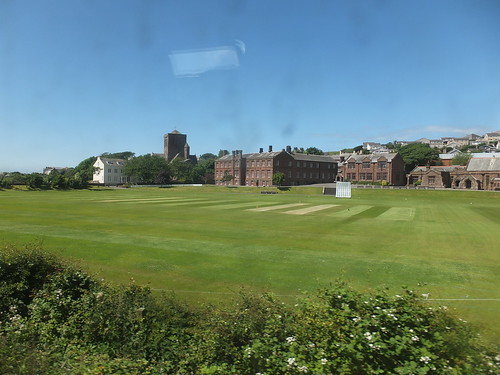 St. Bees School.
St. Bees School.
The line remained inland approaching Whitehaven. I was surprised at the size of the housing estate spread across the hill to our left - mature semi-detached and blocks-of-four housing. The population of Whitehaven, I later discovered, is around 23,000. We stopped at the first of Whitehaven's two stations, Corkickle. This was once the junction with a double-track line to Moor Row although, even then, the two routes converged onto a single platform serving Corkickle with a single line tunnel to the second station, Bransty. The junctions and sidings around Corkickle are long gone but the single platform and Whitehaven Tunnel (1,320 yards long, still single line) remain in use.
The rest of my travels that day are in the post Furness and the Cumbrian Coast (Part 2)
My pictures
Lancaster.
Barrow-in-Furness.
Cumbrian Coast Scenes.
Railway pictures
Carnforth railways.
Furness Line & Barrow.
Cumbrian Coast Line.
Whitehaven railways.
[Link to Part 2 added 1-Jul-2014]
In an earlier post titled simply 'Liverpool', I talked about my introduction to this remarkable city, with brief information about the electrified Liverpool Overhead Railway. The City has clearly continued to hold a fascination for me because quite a number of posts have followed set in or around Liverpool or describing journeys to and from Liverpool.
I've summarised each of these Liverpool-themed posts below, with links to the full post. Links from each full post lead to my photographs.
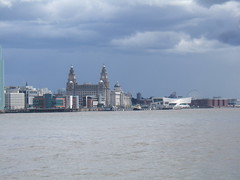
Liverpool viewed from the River Mersey.
'Lion' and OLCO
Part of my interest in Liverpool has been through my involvement with the 'Lion' locomotive 'supporters group', the Old Locomotive Committee (OLCO). 'Lion' is in the care of National Museums on Merseyside and is now a major exhibit at the Museum of Liverpool. You can find all my posts about OLCO and 'Lion' here.
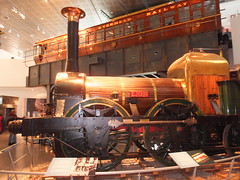
'Lion' and the Liverpool Overhead coach
in the Museum of Liverpool.
By steam to Birmingham
The post 'Black 5' to Birmingham describes what I can remember of a journey in the steam era from Liverpool Lime Street in the 1950s, taking the former L&NWR route via Runcorn, Weaver Junction, Crewe and Stafford to Wolverhampton.

This evocative Ben Brooksbank shot
shows 'Patriot' 45515 at Lime Street.
By train in 2010
To attend an OLCO A.G.M. at the Museum of Liverpool Exhibit Store, I took the L&NWR route to the to the wonderfully-named modern station at Liverpool South Parkway (for Liverpool John Lennon Airport), formerly the rather prosaic 'Allerton' where I was able to change to what was formerly the Cheshire Lines Committee route to Liverpool but which had become part of the 'Merseyrail' network. A Class 350 EMU (25 kV a.c. overhead electrified) took me to Liverpool South Parkway, changing there to a Class 508 EMU (750 V d.c. third-rail electrified) to Bank Hall.
At the Exhibit Store, I was able to study 'Lion' (being readied for display in the new Museum), 'Cecil Raikes' (the massive Beyer-Peacock 0-6-4T which operated on the Mersey Railway prior to electrification), the 'Avonside' 0-6-0T saddle tank (one of the Mersey Docks and Harbour Board shunters) and the preserved Liverpool Overhead Railway Driving/Motor car (also being prepared for display in the new Museum). This trip is briefly described in the post Day Trip to Liverpool.

Bank Hall station (former L&Y Railway).
By train in 2012
Once again, I was attending an OLCO A.G.M., this time held in the new Museum of Liverpool. The A.G.M. is described here. The journey was via the former L&NWR route by a 'London Midland' Class 350 both ways. There's a brief description in the post Liverpool by Train.
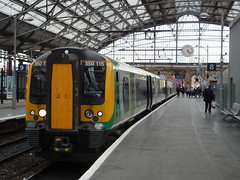
Class 350 at Liverpool Lime Street.
Birkenhead and New Brighton by train
For this trip, I took a Virgin 'Pendolino' service to Crewe, a DMU from Crewe to Chester and then a 'Merseyrail' EMU to Birkenhead. I indulged my interest in Scherzer Rolling Lift Bridges by walking extensively around the dock area, looking at three remaining examples of this ingenious design of moveable bridge. 'Merseyrail' then took me on to New Brighton, by which time the weather had deteriorated. I returned to Wolverhampton via Birkenhead and Chester, as my outward journey. The trip is described in three posts - the first is Birkenhead and New Brighton by train (Part 1), with links to the other parts.
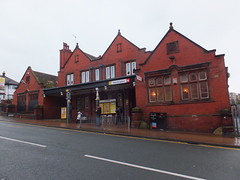
New Brighton station from the roadside.
By train in 2014
This time, I took the former Great Western Railway route from Wolverhampton to Shrewsbury (change) then on to Wrexham General. Another change let me travel on the former Great Central Railway to Bidston. The route from Wrexham to Bidston is now marketed as 'the Borderlands Line. The first three trains had been DMU but at Bidston, I joined a Merseyrail EMU on to Liverpool. I wandered around the city, called in to see if 'Lion' was still safe in the Museum of Liverpool (she was) and then couldn't resist taking the iconic Mersey Ferry to Birkenhead. Another Merseyrail EMU took me to Bebington, where I visited the Lady Lever Art Gallery before taking another EMU to Chester. I returned home via the former Great Western Railway via Wrexham and Shrewsbury. Two posts describe this trip:-
By rail to Liverpool (Part 1)
By rail to Liverpool (Part 2).
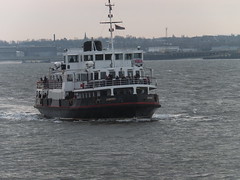
Mersey Ferry 'SNOWDROP'.
Early Days of the Mersey Railway
There's a little history about the Mersey Railway here.
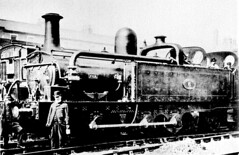
Mersey Railway 0-6-4T 'Fox'.
The Mersey Docks and Harbour Board
There's a short post here.
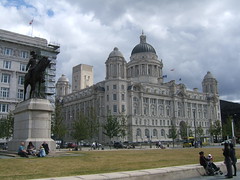
The Dock Office, Pierhead.
Edge Hill, Liverpool
The Edge Hill area of Liverpool has been associated with railways since 1830, when the Liverpool and Manchester Railway opened its first passenger terminus at Crown Street. There's a little about the history and growth of the railways around Edge Hill in the post Edge Hill, Liverpool.
Intrigued to know how much of the original railway infrastructure survived, I re-visited Edge Hill in June 2013 and carried out a fairly extensive walking tour. I reported on what I found in the post Railways around Edge Hill in 2013.
On the Edge Hill Station Site I found a series of photographs which I concluded showed a 'Steam Special' changing engines at Edge Hill in 1954. The post Northern Rubber Special gives my suggested explanation of these intriguing photographs.

Edge Hill Station Buildings (1836).
Liverpool Lime Street Station
The former L&NWR terminus in Lime Street still retains much of its former grandeur and the two massive trainsheds have been quite well restored. My post Liverpool Lime Street Station gives a little history.
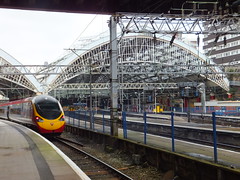
Liverpool Lime Street station.
The other principal stations in Liverpool have not fared so well. The L&Y Liverpool Exchange survives only as a frontage (albeit a handsome one) and little remains of the Cheshire Lines Committee terminus at Liverpool Central High Level. The excellent 'Disused Stations' site features both Liverpool Exchange and Liverpool Central High Level.
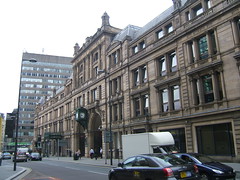
The facade of Liverpool Exchange station today.
More recent posts in this blog
Notes on Liverpool and its Docks.
Merseyside in December.
My pictures
Liverpool area rail.
Merseyrail.
Liverpool.
Birkenhead and its Docks.
New Brighton.
Port Sunlight, Wirral.
Museum of Liverpool.
Royal Visit to the Museum of Liverpool.
Audio Visual Systems at the Museum of Liverpool.
[Updated 30-Dec-2016]
The Old Locomotive Committee (OLCO) is the 'Supporters Club' for the 1838 locomotive 'Lion' and 'Lion' models. The 30th Annual General Meeting of OLCO was held in the Museum of Liverpool on Saturday, 14th June 2014.
Through the courtesy of the Museum's Curator of Land Transport & Industry, Sharon Brown, this was the third time that the A.G.M. had been held at the Museum. There's are brief reports on the A.G.M. in 2012 here and the A.G.M. in 2013 here.
On the day of the 2014 OLCO A.G.M., the Museum was also hosting an International Conference titled The Un-Straight Museum. The conference ran in conjunction with a year-long exhibition at the Museum titled April Ashley: Portrait of a lady. It was also the weekend of the The International Mersey River Festival: On The Waterfront (the music for which provided various 'noises off' from time to time).
The A.G.M. was accommodated in Education Room 2 on the first floor. Sharon had provided tea, coffee and biscuits for which members were very grateful. The Chairman of OLCO, John Brandrick, opened the formal A.G.M. at 1.00 p.m. and welcomed those attending. The Agenda items were dealt with promptly and the Election of Officers (once again) resulted in no changes to those serving in the previous year. There was lively discussion during 'Any Other Business' and the Chairman closed the meeting at 3.05 p.m. Members of the Old Locomotive Committee will receive formal minutes of the proceedings in due course.

The 30th A.G.M. in progress.
Those attending then moved to the Great Port Gallery, where 'Lion' is on display, for technical discussions and a group photograph. We couldn't help noticing that the audio-visual presentations about 'Lion' (briefly described in an earlier post here), had stopped, although they'd been working in the morning.

Alan, John, Jan, Jon, David, Sharon and John in front of 'Lion'.
More on this website
The Old Locomotive Committee (an introduction to 'Lion' and OLCO).
All my posts about OLCO activities are here.
More on other websites
Lion & Old Locomotive Committee (the website of the Old Locomotive Committee).
My Pictures
OLCO A.G.M. 2014.
All my pictures showing OLCO events are in the collection The Old Locomotive Committee and Lionsmeet
Click on any picture below to see an uncropped image.
In 2008 I made my first visit to Myanmar (formerly Burma) and travelled on Yangon's suburban railway. The railway trip is described in the post The Circle Line, Yangon.
In a later post, Yangon Area Railways, I described the colour light signalling on the railways around Yangon. I'd discovered that in January 1946, following severe damage to the railways around Yangon during World War II, an order was placed with Westinghouse Brake and Signal Company for two Style 'L' miniature lever frames for Burma Railways. They were intended for 'Rangoon' and 'Kemmendine'. At that time, I hadn't found the signal box at Yangon (as Rangoon is now called) and I was puzzled about Kyee Myin Daing (as Kemmendine is now called) because I'd seen two mechanical signal boxes there, still apparently in use.
In February 2013, shortly after writing the Yangon Area Railways post, I made another visit to Yangon. This time, I located Yangon Central Power Signal Box and, although confined to public areas, confirmed that the Style 'L' miniature lever frame was still in use. I wrote about this discovery in a post here.
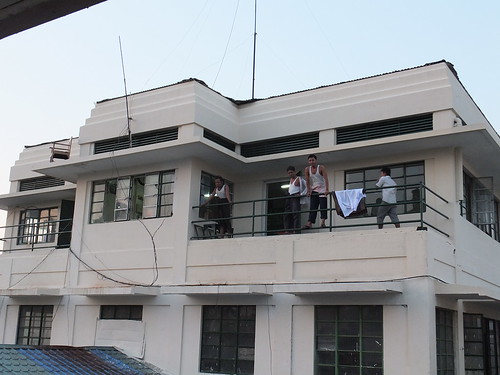 Yangon Central Power Signal Box in 2013.
Yangon Central Power Signal Box in 2013.
On my next trip to Burma, my friend Doctor Hla Tun made arrangements on 25th April 2014 for me to visit Yangon Central Signal Box and make a cab ride around the Circle Line. The day is briefly described in the post Exploring Yangon's railways.
The Style L Power Frame
Early miniature-lever Power Frames retained mechanical interlocking between the levers, in a similar fashion to purely mechanical lever frames. But as installations became more complex, the problems of providing mechanical interlocking in the limited space available increased. The Style L Frame introduced by Westinghouse Brake and Signal in 1929 interlocked the miniature levers electrically. This meant that a large frame could be installed in two or more sections, if that was operationally more convenient. For instance, the frame at Waterloo was divided into three sections and that at Crewe North Junction into two sections. In addition, all the interlocking was on the operating floor of the signal box. In front of each lever an engraved description or lead plate was provided. Behind each lever, on an almost vertical panel, are the repeater lamps.
Movement of a lever has two actions:-
1) Through a link piece, the lever moves a horizontal lock slide extending to the rear of the frame. Suspended below the lock slide is a sealed Interlocking Magnet which allows or prevents lever movement. A second, smaller Indication Magnet is also provided.
2) Through bevel gearing, movement of the lever rotates a vertical shaft through 120 degrees. Each shaft can mount up to 36 phosphor-bronze electrical contact bands. Where additional contacts are required, a further bevel gear is provided at the rear of the lock slide, rotating a second vertical shaft at the rear of the frame, allowing a further 36 contacts to be fitted.
For more detailed information, refer to Mr. Francis' excellent book [reference 1].
My visit to Yangon Central Power Signal Box
I was made very welcome by two signalmen, a senior signalman, a regulator and a train announcer. Most had some English. Just as well, because the frame, the illuminated diagram and all the lever description plates were in English. That made it a lot easier for me to work out what was going on. I've noticed before when overseas that because most railways work in similar ways, it's possible to work out quite a lot even if you can't ask questions of the local staff, so I quickly felt at home.
The lever frame dominated the signal box - 143 minature levers in one straight line with an illuminated track diagram behind.
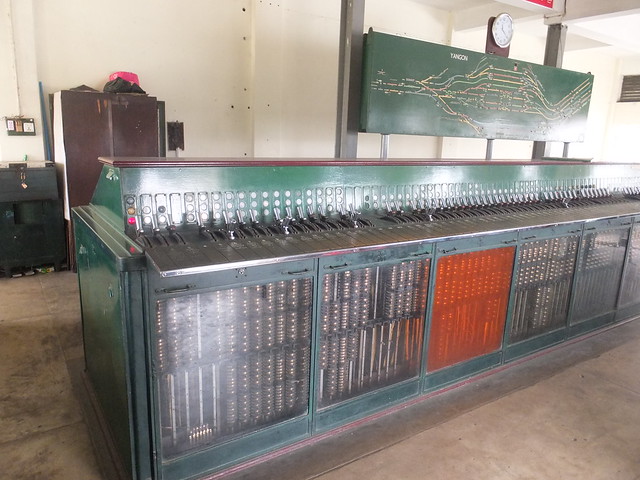 General view of the Style L Power Frame and Illuminated Track Diagram at Yangon.
General view of the Style L Power Frame and Illuminated Track Diagram at Yangon.
There were some signs that the frame might be getting 'tired' - occasionally a signalman would 'jiggle' a lever, perhaps because of a sticky lock. The lever description plates appeared to be engraved brass, filled white. All the repeater lamps were, as normal, fitted on the nearly-vertical panel behind the levers. Points displayed the usual 'N' (normal) or 'R' (reverse).
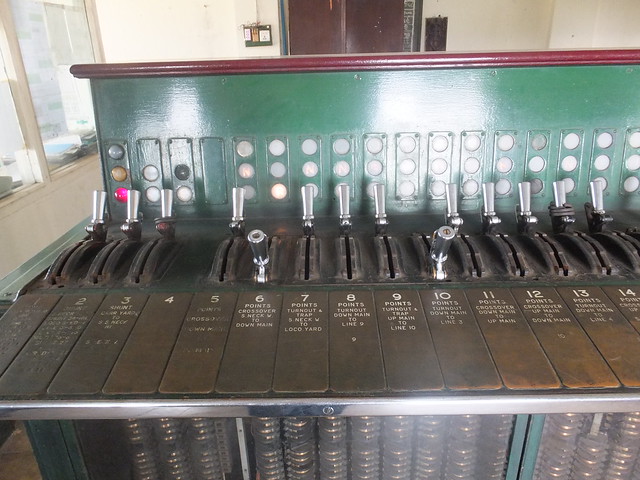 Detail of left end of the frame.
Detail of left end of the frame.
The front access panels were plastic glazed, so all the electrical contacts on the front vertical shafts were visible.
 Vertical contact shafts at the front of the frame.
Vertical contact shafts at the front of the frame.
Looking from the rear of the frame, there were similar access panels plastic glazed across the top allowing the lock slides and the associated mechanics to be seen. The interlocking magnets themselves were below the top plate but the positions they occupied were visible. Finally, there were vertical rear access panels, plastic glazed (similar to those at the front), allowing inspection of the electrical contacts on the rear vertical shafts.
Conventionally, the relay room was below the operating floor but I was only able to see it through the vision panel on the padlocked door.
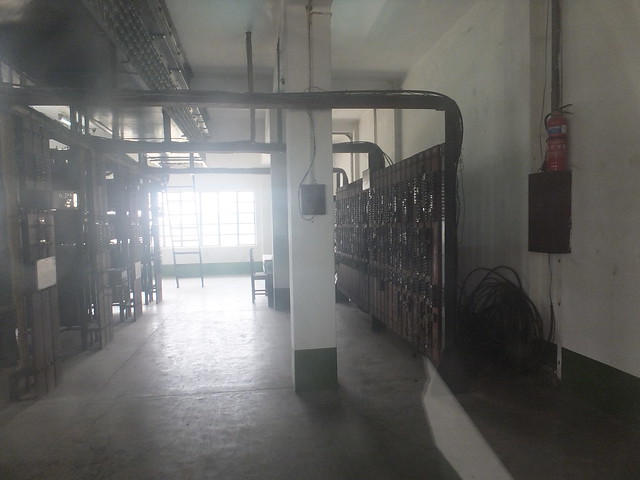 View of the relay room. Racking with large shelf-type relays on the left and cable termination panel on the right.
View of the relay room. Racking with large shelf-type relays on the left and cable termination panel on the right.
Operations at Yangon Central Station
It's always interesting to watch operations around Yangon Central station but, of course, the Power Signal Box gives the best view. There are two balconies at the front of the signal box and the signalmen make frequent use of them to check exactly where trains are.
Subsequent changes
Since the visit in 2014 described in this post, the signalling around Yangon has been modernised. The new arrangements are described in the post Railway Operation Control Center, Yangon.
Books
[reference 1] 'The Style L Power Frame' written and published by J. D. Francis 1989 (ISBN 0 9514636 0 8).
My Pictures
Yangon Central Power Signal Box.
You can find all my albums of pictures showing Burma Railways here.
More
Myanma Railways (Index)
You can select all my posts about railways in Burma (in reverse date-of-posting order) here.
There's a post about Crewe North Junction Signal Box here with a little more information about (and more photgraphs of) the Style L Power Frame.
[Minor update & link to 2020 post added 31-Mar-2020]
Click on any picture below to see an uncropped image.
I returned from a trip to Burma on 9th May 2014. There's a series of posts describing the trip (starting at Back to Burma with links to later posts in order). This wasn't a railway holiday but I did manage a visit to the power signal box in Yangon and a diesel cab ride around Yangon's Circle Line (there's a brief description in Exploring Yangon's Railways with links to my pictures).
I had a few days to recuperate before my next footplate turn at Peak Rail on Sunday 18th May.
Events of Sunday 18th May 2014
I was booked with Harvey and we started the day with a footplate experience course. Our trainee was a very pleasant young man who, we discovered, had just married and was with his charming wife. It seemed an odd format for a honeymoon but after the course, they both enjoyed a ride on the train and I managed a picture of them both on 'Lord Phil' at Matlock Town. We extend our best wishes for the future to this couple.
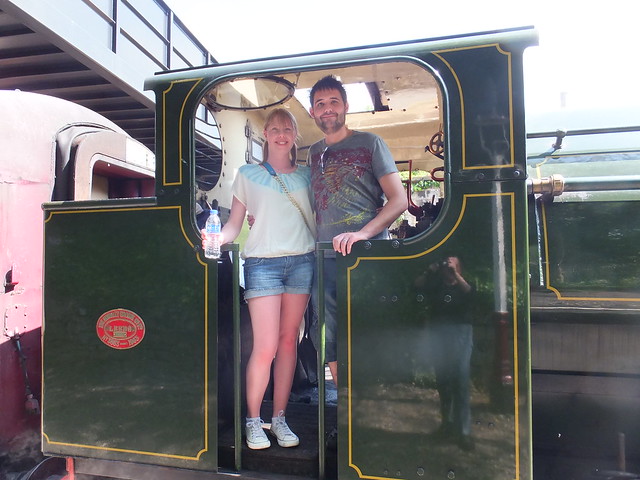 Newly-weds Mr. and Mrs. Yeend on the footplate of 'Lord Phil' at Matlock Town.
Newly-weds Mr. and Mrs. Yeend on the footplate of 'Lord Phil' at Matlock Town.
The format for the passenger service was five rounds between Rowsley and Matlock Town, top and tailing with 'Penyghent'. The only exceptional event was that the weather remained hot all day and at times it was a bit warm on the footplate.
Before our final departure of the day from Rowsley, the station staff asked us to do our best to be 'right time' at Matlock Town as two lady passengers were hoping to make the connection with the East Midland Trains service at Matlock and make a further connection at Derby as they were travelling back to London. We didn't let them down.
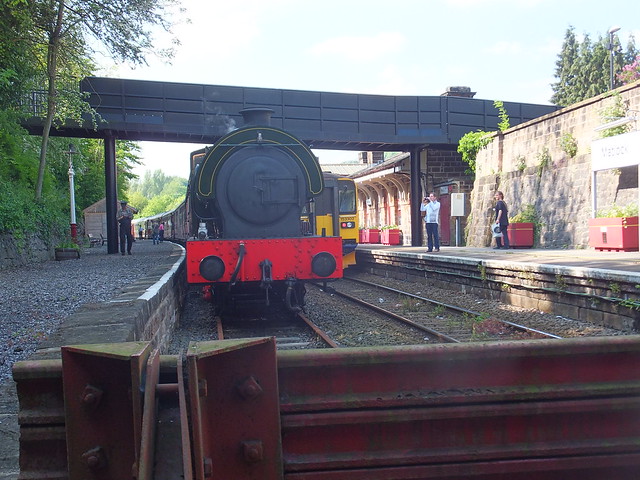 'Lord Phil' at Matlock Town standing next to an East Midlands Trains Class 153.
'Lord Phil' at Matlock Town standing next to an East Midlands Trains Class 153.
Events of Sunday 26th May 2014
My next turn was with Dave on Sunday 26th May. We were joined by Jacob, on his first Cleaning Turn. The weekend had been advertised as the Mixed Traffic Weekend. Heritage Shunters Trust were running brake van rides at Rowsley, and they rang the changes on the motive power in use, providing an excellent attraction. But shortage of motive power for the service trains meant than it had been decided to operate only the normal service of five top and tailed round trips between Rowsley and Matlock. 'Lord Phil' was on the south end of the train, with Peter Briddon's preserved 'Teddy Bear' locomotive 14 901 on the north end. Wikipedia has a description of the 'Class 14' here.
It was as well I'd taken my heavy overcoat because the weather was quite different from that on my previous turn described above. On my arrival, the rain was sluicing down and it remained pretty wet all day. When it's raining, it's impossible to prepare a steam locomotive standing in the open without getting thoroughly bedraggled and it took me some time to dry out afterwards. But, leaning out of the cab for better visibility when on the move and taking water periodically during the day at Rowsley means that, as soon as you've dried out, you get drenched again. As I often say "Anyone can work on a locomotive when it's fine but it takes an engineman to do it when it's wet".
Fortunately, by the time we arrived back at Rowsley on the last trip, the rain had stopped, so we were able bring the light engine 'on shed' and dispose without another soaking. Disposal is unattractive enough at the best of times - the fire has to be 'knocked out', ash removed from the ashpan, char removed from the smokebox. There's a brief description of the process in the post MIC - Disposal
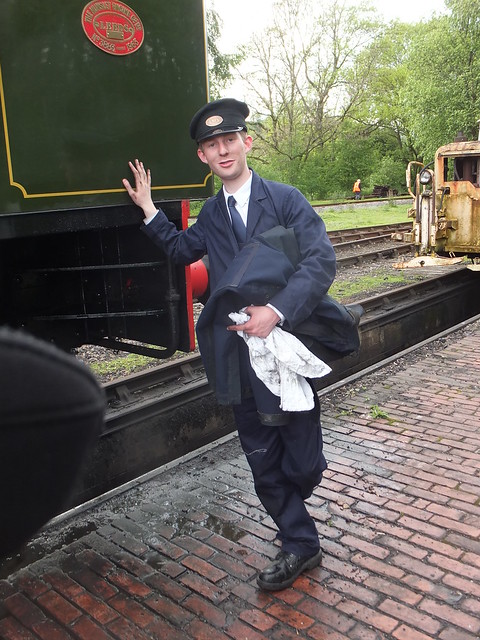
Jacob beside 'Lord Phil' at the end of his first turn as a Cleaner.
My Pictures
Peak Rail, May 2014.
You can find all my Peak Rail Pictures here.
More
You can find all my Peak Rail Posts here.
Click on any picture to see an uncropped image or browse the albums listed in 'My Pictures' below.
Events of Thursday 8th May 2014
Leaving Yangon
I was leaving the Strand Hotel too early to take breakfast in the cafe, but an excellent light breakfast was served in my room. My 'regular' driver was waiting for me in reception, so we were on the road to the airport in good time. Check-in was painless, so I was soon making my way upstairs and passing through immigration. Check-in staff had told me that Qatar Airways now have their own lounge so all I had to do was find it. With that task successfully completed, I was welcomed into the lounge, which was nicely appointed and gave views over both the Departure Hall and the Stand which our aircraft would use.
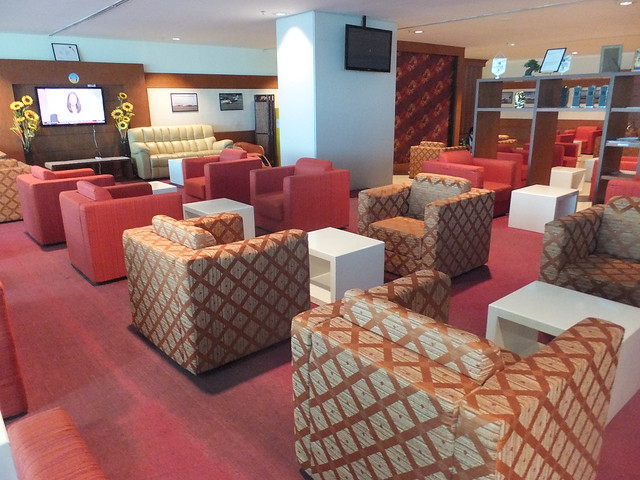 The Qatar Airways Lounge at Yangon Airport.
The Qatar Airways Lounge at Yangon Airport.
The inbound A319 aircraft from Doha was a little late arriving.
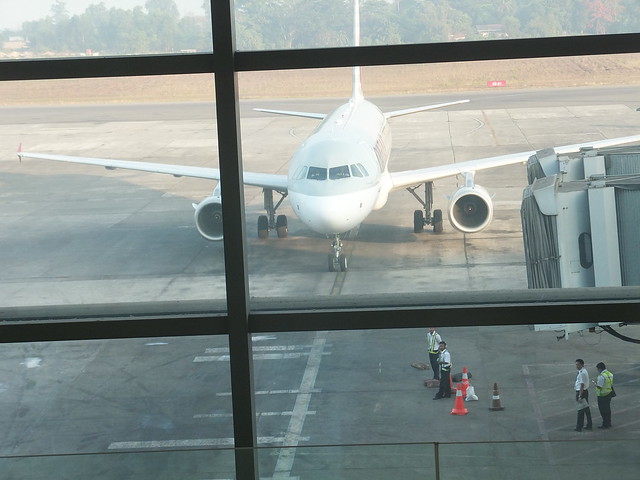 The inbound aircraft taxis to the Stand.
The inbound aircraft taxis to the Stand.
Arrival would trigger a flurry of activity - passengers off, luggage and cargo unloaded, crew off. Cleaners would rapidly prepare the aircraft for the flight back to Doha. A new crew would take over the aircraft, luggage and cargo be loaded and eventually the waiting passengers (including me) would board. Depending upon the flight details, the aircraft might need to upload more fuel, water, catering supplies or empty the lavatory tanks. I only saw some of these activities.
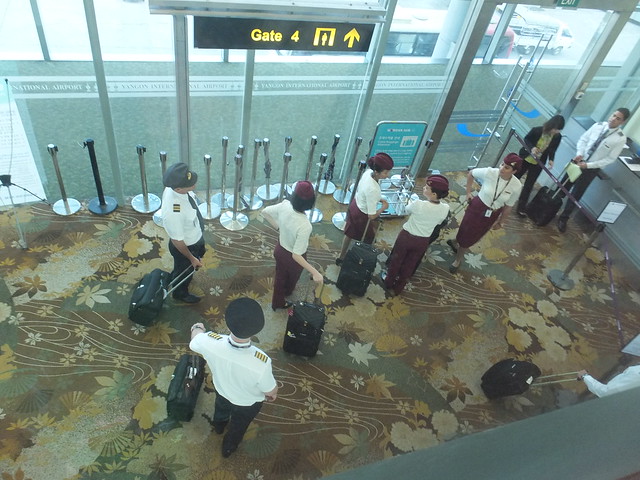 The new Crew gather at the Gate waiting to board the aircraft.
The new Crew gather at the Gate waiting to board the aircraft.
I saw the new crew go on board and before long, a Boarding Call was made and the waiting passengers began to empty the Departure Hall and make their way to the aircraft. Before long, I'd moved to my comfortable seat in the front cabin of the A319.
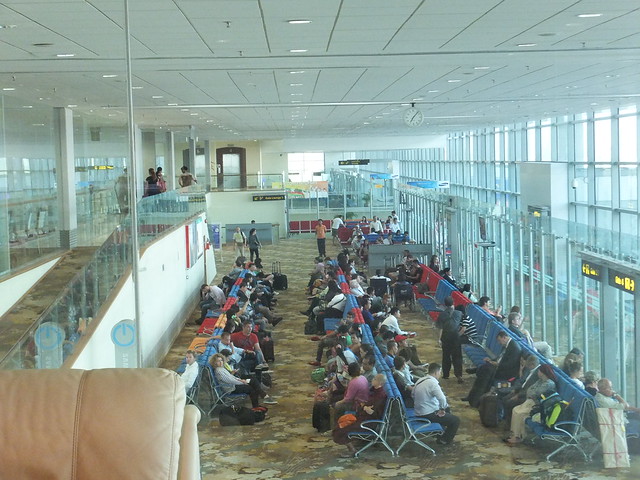 Passengers waiting in the Departure Lounge for the Boarding Call.
Passengers waiting in the Departure Lounge for the Boarding Call.
We left Yangon a little late and we still a little late when, hours later, we touched down at Doha Airport in Qatar.
Arriving in Doha
On the eastbound leg, I'd been able to transit at Doha, leaving one aircraft and joining another with passing through Immigration. But, travelling westbound, the times of the flights didn't allow that so I'd arranged a hotel for one night. This meant purchasing a visa on arrival. The lady Immigration officer asked if I wanted to purchase a visa, I said yes and handed over a credit card and in moments it was done.
I'd booked (and paid for) a transfer by car to my hotel. My itinerary said I was to find my driver at a particular Car Hire Desk in the Arrivals Hall. Here's where the plan unravelled. I found the correct desk but no driver. The Desk was manned by one man who seemed to be completing a car hire for a waiting businessman. It appeared to be an unusually complicated hire because it was twenty minutes before I succeeded in getting the car hire guy to acknowledge my presence. I showed him my booking receipt and the made a quick call on a mobile, with some reluctance it seemed to me. "Wait over there - the car is coming from the parking garage" he announced, quickly disappearing with his customer and a form to log pre-existing body defects on the car he'd hired.
After another 30 minutes waiting (neither the booked car nor the car hire guy had appeared), a rather grumpy Jan accepted a quote from one of the drivers looking for trade and we walked out of the air-conditioned terminal into the dry heat of Qatar and across to the parking garage. The car was an up-market, modern saloon (with air conditioning, of course) and once we were under way, my mood quickly improved.
By Road to the Hotel
The city appears to have developed initially around a semicircular bay, open to the Gulf in the east. The bay has a pedestrian promenade, Al Corniche, somewhat reminiscent of a Victorian seaside town. On the landward side of the promenade, there's a multi-lane highway called Al Corniche Street, always teeming with traffic. Further inland there are more roads, concentric with the promenade.
At the southern end of the bay, Doha Port and Qatar Flour Mills have been built incorporating a series of jetties and reclaimed land, jutting out into the Gulf. The airport is on more reclaimed land south of the city and the road we took from the airport led onto Al Corniche Street. Near a monument called The Pearl, the Museum of Islamic Art is actually built in the bay and a little further west, there is the smaller Dhow Harbour which also appears to be formed from modern jetties and reclaimed land. There's a satisfying tangle of wooden boats here.
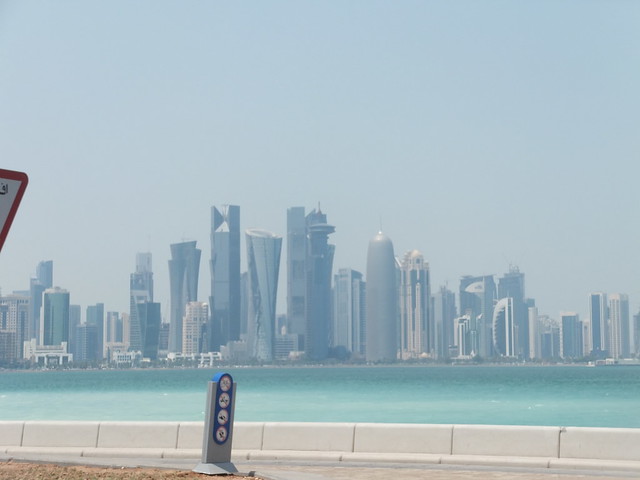 View of the amazing skyline from across the Bay.
View of the amazing skyline from across the Bay.
Continuing around the bay, the buildings on the landward side become taller, each vying with the next to be more preposterous than its neighbour. Near the northern end of the bay, Al Corniche Street moves inland a little and the space between the road and the promenade is Sheraton Park, with the Msheireb Enrichment Centre set in the bay, like a small version of the Museum of Islamic Art. Nearby is the oddly-shaped Sheraton Doha Resort and Convention Hotel. Al Corniche Street continues slightly inland (there's a large building site on the seaward side) and enters the Diplomatic Area, which is now also home to a number of hotels including the Movenpick Tower and Suites, where I was booked.
Movenpick Tower and Suites, Doha
Of course, this hotel is unashamedly modern (there's also a somewhat older Movenpick in Doha which I'd spotted on my journey from the airport).
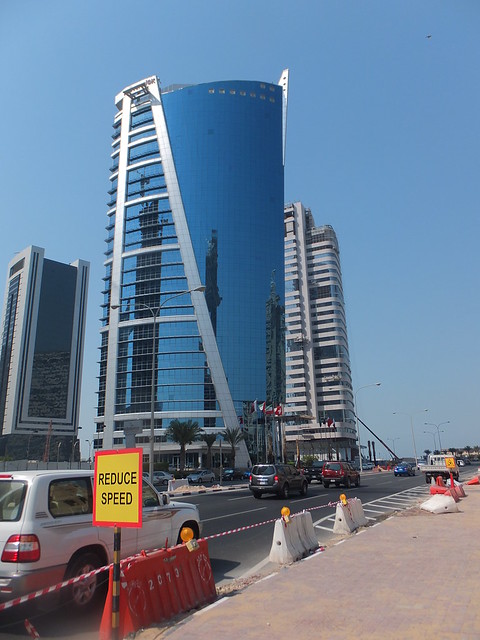
Movenpick Tower and Suites, Doha.
Any reservations I might have had were quickly dispersed by the friendliness of the check-in staff. They upgraded me to a suite for the night (which didn't hurt, either). A porter took me up in the lift and showed me the accommodation. The large lounge area had a curved picture window along the seaward side giving good, but not uninterrupted, views of the Bay because a number of multi-storey buildings lay between the Movenpick and the sea. I was quite content, even though the decor was a little 'jazzy' for my taste.
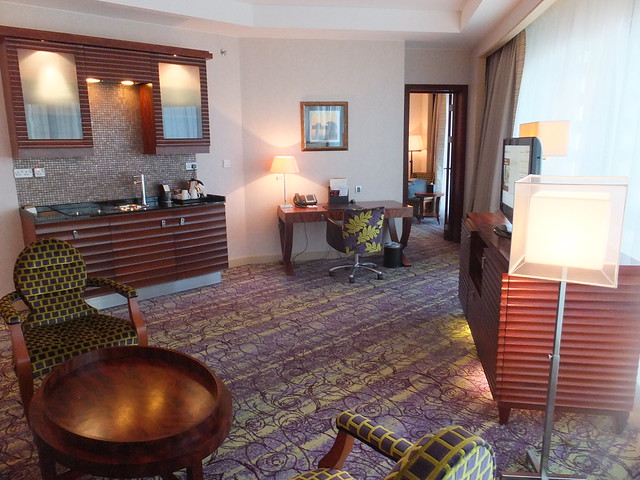 View of the lounge, with the bedroom beyond.
View of the lounge, with the bedroom beyond.
A Walk in the Sun
Although tired, I thought I ought to explore a little outside the hotel and decided on a walk around the district. It was already clear that Doha is not a place intended for walking - cars, preferably large and expensive, are the normal means of transport. It was also quite hot, of course but, having applied a dose of sun screen, I left the hotel and started to walk south.
The wide roads are normally provided with broad pavements but I quickly discovered that all the building and road projects under way meant that many of the pavements were impassable. Displaying my trademark stubborn streak, I pressed on, meeting only construction workers toiling in the hot sun, all swathed in high visibility clothing and hard hats which I would have found intolerable. Of course, Qatar, in common with other Gulf States, tends not to use its citizens for hard manual labour. Rather, it admits 'Guest Workers'. As Qatar prepares for the contentious Football World Cup it has been awarded, there has been frequent criticism of the number of construction-related accidents affecting guest workers.
I discovered that the large building site near the Sheraton Doha Resort and Convention Hotel being developed by Qatari Diar will become a car park with three subterranean levels topped by a park. I walked across Sheraton Park towards the Bay. I was amused that the adventure playground was fitted with some form of canvas roof as a sun screen. However, there were no happy families, just the ubiquitous construction workers.
Looking across the Bay, I could see Doha Port. The deck cargo on an unidentifiable ship with stern ramps comprised new lorries and buses, presumably about to be unloaded. Nearby, an area held stacks of shipping containers. Another ship I was able to identify afterwards was 'Rising Eagle', home port Kingston. This is a bulk carrier built in Japan in 1995 and earlier called 'Full City'. Her four large deck cranes were all deployed. She was tied-up next to a tall, white building which I presumed was Qatar Flour Mills. Since I spotted this ship, she has travelled to Kandla (India) and back to Abu Dhabi. Later, I watched another ship arrive. This had distinctive lines of a Car Carrier, presumably bringing another consignment of top-of-the-range cars to Qatar. I identified the ship later as 'Aphrodite Leader' operated by NHK Lines, Panamanian-flagged and built in 2007. Since my sighting, this ship has been to Laem Chabang (Thailand), Singapore, Jeddah (Saudi Arasbia) and, at the time of writing, is in the Red Sea heading south. Modern ships work hard!
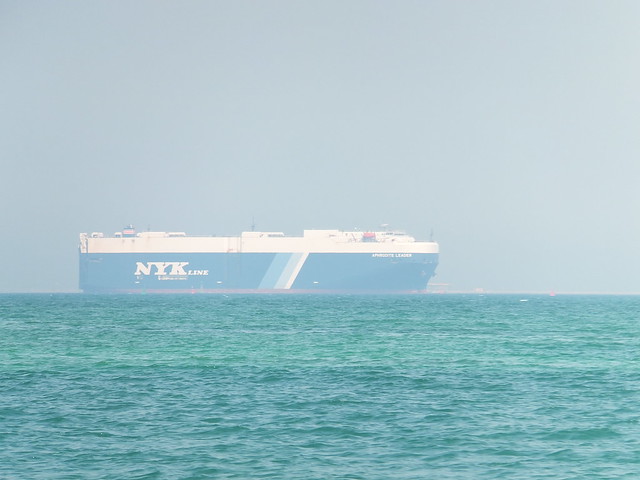 'Aphrodite Leader' arriving at Doha Port.
'Aphrodite Leader' arriving at Doha Port.
On the landward side of the park, massive buildings reared up. Looking at the one with the spire, I kept thinking of Emperor Mong's spaceship in 'Buck Rogers'.
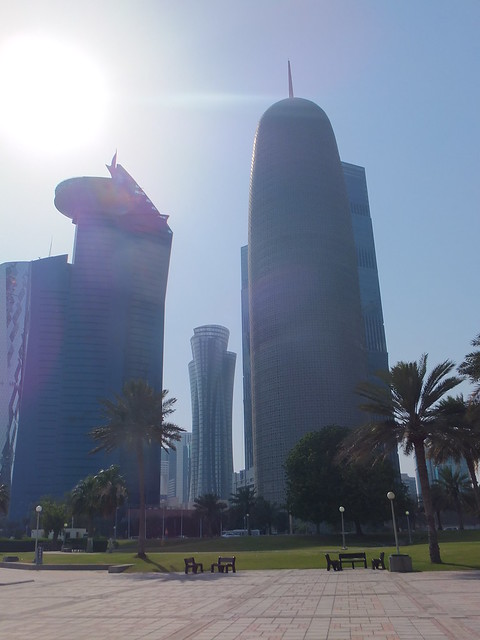
Massive buildings on the landward side of Sheraton Park.
A broad piazza led to the Msheireb Enrichment Centre which appears to be built on a large barge connected to land by two broad gangways and a short stone causeway. You can find out more here but I'm afraid I was a little put off by its claim to be "a landmark destination created by Msheireb Properties to serve as an educational portal to showcase Qatar's glorious past and soaring ambitions for the future". Nearby, on the piazza I found a 'Costa' coffee shop (no comment).
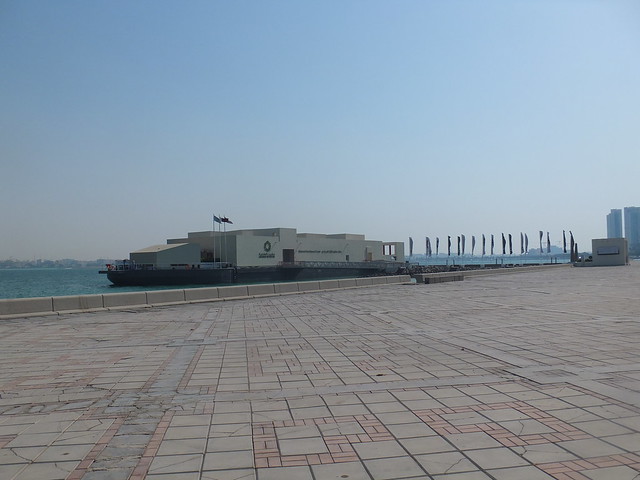 Msheireb Enrichment Centre
Msheireb Enrichment Centre
The Bay itself remains attractive. I sat for a while near the warm waters (had there been any beach I would certainly have paddled, like the bird in the picture below).
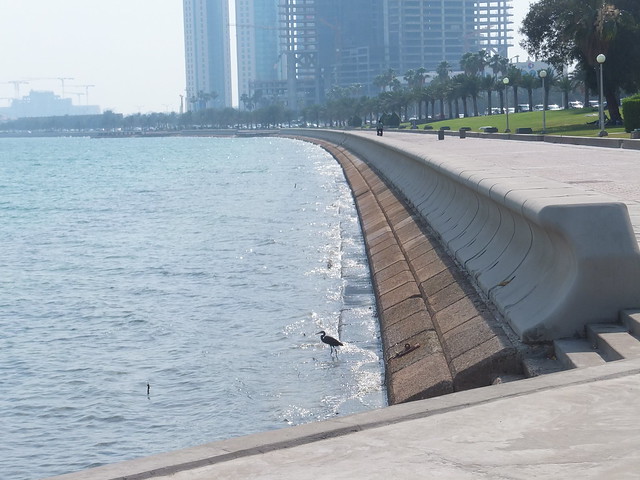 Al Corniche Promenade, looking south from Sheraton Park.
Al Corniche Promenade, looking south from Sheraton Park.
I decided that, although I'd seen little of Doha, I'd perhaps better return to my hotel - it was still very hot and I had another early start the following day to catch my flight to Manchester. One small incident I observed on the way back amused me. Because of all the road works, the area was well-plastered with alternating red and white plastic barriers (all stencilled 'BOOM'). I watched an Ashok Leyland bus approach a junction on a lane narrowed by barriers. He just couldn't make the turn and gently pushed at the plastic barriers but still hadn't enough room. A passenger left the bus to shove a number of barriers out of the way until the bus could complete the turn. All the passengers were dark skinned, dark haired and all wore white shirts. I decided they were probably 'guest workers' being returned to some sort of barracks at the end of their work day.
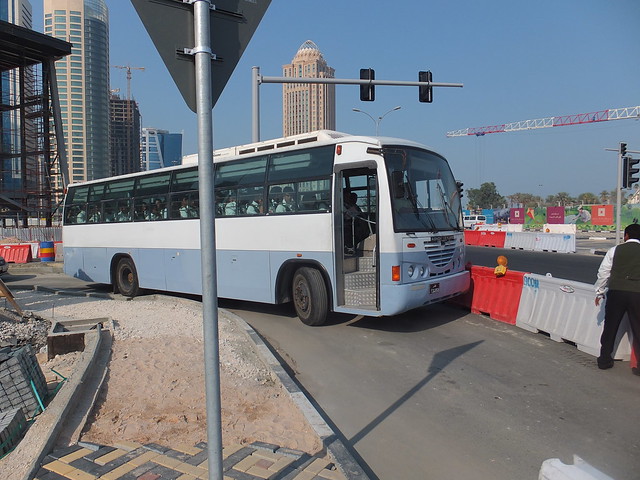 The bus that couldn't quite make the turn. Click on image above for an uncropped view showing the plastic barriers being moved clear.
The bus that couldn't quite make the turn. Click on image above for an uncropped view showing the plastic barriers being moved clear.
Back at the hotel, I treated myself to a meal in my room and went to bed, in preparation for an early start the next day.
Events of Friday 9th May 2014.
After the fiasco of the missing car on my arrival in Doha, I wasn't too confident about being transferred back to the airport, although reception had assured me they could soon rustle up a hotel car if needed. However, when I went down to reception early Friday morning, a driver was already waiting for me and we had an uneventful journey around the bay to the airport. The varied architecture was as surprising as it had been on my arrival. Still under construction, the National Museum of Qatar designed by Jean Nouvel looked as if it had suffered a terrible accident but perhaps it will be alright once finished when "a collection of disks, some vertical, some near horizontal, interlock and create a volume".
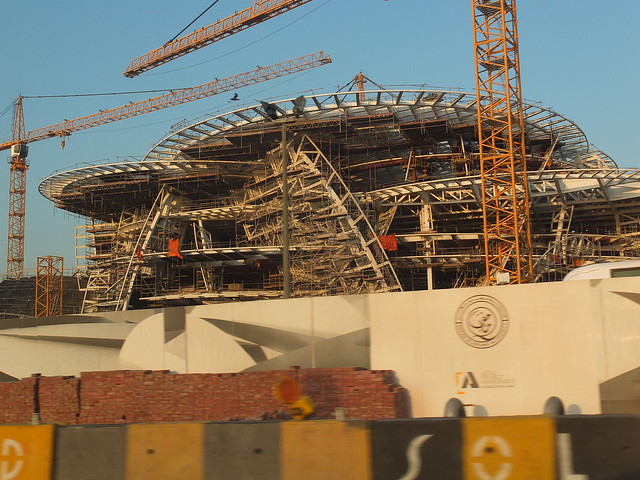 The National Museum of Qatar under construction.
The National Museum of Qatar under construction.
We passed a cheerful cautionary road sign with a cartoon traffic policeman and the slogan (in English) 'Speed Leads to Ruin'. But the picture of a car speedometer indicated 250 km/h! Not that many cars over here would manage to get up to 150 miles per hour.
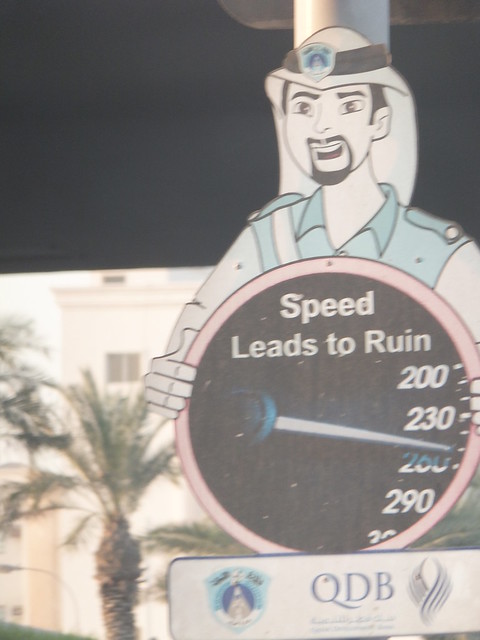
The speed warning sign.
At the airport, check-in was quick and friendly. It took me two attempts to find the right lounge but, again, everybody was very friendly and I relaxed watching the various passengers come and go. At the appointed time, I made my way to the Gate and was directed downstairs to a Departure Lounge overlooking the main internal airport road. I had a few minutes to wait for the next transfer bus which would take me from the Departure Lounge to the aircraft, whilst a steady stream of airport vehicles passed on the road outside and, every couple of minutes, an aircraft roared past on the runway at the far side of the road.
They'd been building a new airport terminal and, a few days after my departure, the new Hamad International Airport terminal opened for use, modestly claiming to "exceed expectations and redefine passenger transit experience". I presume most transfer buses have been replaced by Air Bridges, connecting the terminal directly to the aircraft.
 The view from the Departure Lounge.
The view from the Departure Lounge.
The flight from Doha to Manchester was in an A330 with a particularly pleasant crew who looked after me very well. The four Qatar Airways flights I had on this trip left me with a very favourable impression of the airline. I watched some films and finally went for 'The Lego Movie', expecting to find a CGI film with Lego characters dire. Er, I loved it.
John met me at Manchester and brought me home after one of the most tiring and fascinating trips I've made.
My Pictures
Strand Hotel, Yangon.
Yangon Airport.
Doha Airport.
Movenpick, Doha, Qatar.
Qatar.
More
This is the last in a series of posts describing my trip to Burma in 2014. You can find them all here or go back to the first post in the series Back to Burma (with links to go to each subsequent post in turn).
[Revised 11-Jun-2014, 12-Jun-2014]
Click on any picture to see an uncropped image or browse the albums listed in 'My Pictures' below.
Events of Wednesday 7th May 2014
Walking in Yangon
I enjoyed a leisurely breakfast in the Cafe at the Strand Hotel. I managed to contact both Doctor Hla Tun and Captain Myo Lwin on the telephone and we all arranged to meet in my hotel later in the day.
Although still fairly exhausted, I decided I'd take a walk in the city. There's always so much to see and the legacy of Britsh-inspired buildings is a permanent fascination. There's a useful book [reference 1] on Heritage Buildings in Yangon, with the delightful sub-title 'Inside the City that captured Time'. I decided to head north, away from the river but, instead of taking the major thoroughfare Pansodan Street, I took the narrower street to the east, Seikanthar Street. My first discovery was that the side of the Strand Hotel was being cleaned. Four men were clinging to two rather primitive rope ladders with bamboo 'rungs', scrubbing away at the walls. One man on the flat roof was controlling the water supply to two flexible plastic pipes dangling by the cleaners.
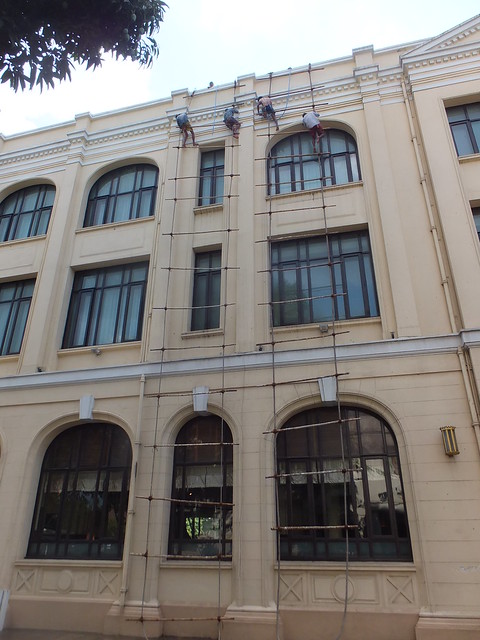
Cleaning the Strand Hotel.
I passed a number of Colonial-era warehouse buildings and a few commercial/residential buildings, none in a very good state of repair. These were interspersed with more modern apartment blocks, usually seven storey.

Seikanthar Street, looking north.
What was most striking was that this appeared to be 'Computer Street'. Most of the ground floor businesses were selling computers, mobile phones, audio equipment or 'white goods'. Rather than the usual crowded jumble of stock, most of the premises were well-lit, western-style showrooms and most of the posters were in English, with only the occasional Burmese text.
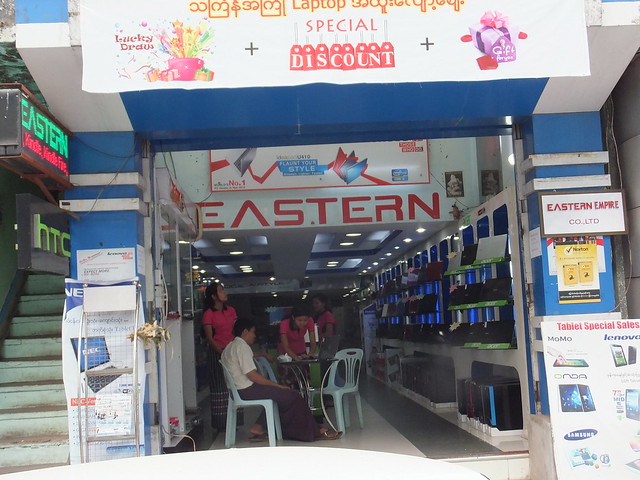 The Computer Showroom of Eastern Empire Co. Ltd.
The Computer Showroom of Eastern Empire Co. Ltd.
Not far from these showrooms selling 'state of the art' products, I passed a more low-tech business - a one-man mobile snack bar. Two specially-made small wooden tables carry two metal pots of food plus accessories. Four metal supports rising from each table are gathered into a supporting ring. The owner has a wooden yoke so that, to move to another location, the supporting ring on each table is threaded onto each end of the yoke and the whole weight can be carried on the owner's shoulders. There were also three small moulded plastic stools for the customers which (elsewhere) I've seen wedged into the framework of the wooden tables whilst the whole set-up was being moved.
 Mobile Snack Bar, Burmese-style.
Mobile Snack Bar, Burmese-style.
Yangon Central Station
Perhaps inevitably, when I reached Bogyoke Aung San Road (which runs east-west, south of the railway), I climbed the steps of the bridge which gives access to the station and descended onto platform 7 (one of the three 'suburban' platforms). One of the new Japanese diesel railcars was standing in the platform, covered in advertising, but before I could draw level, it departed westwards.
The rear of the train carried its running number 'RBE-P5032' on one panel and 'Gold Roast COFFEE MIX' on the other - another triumph for marketing, I suppose, just like the ghastly trains with advertising running around in Britain.
 Japanese diesel railcar leaving Yangon Central Station.
Japanese diesel railcar leaving Yangon Central Station.
City Hall
I slowly made my way back towards the hotel, this time using the busy Pansodan Street. At the junction with Mahabandoola Road, I passed City Hall - a curious but imposing confection in Britsh - Myanmar style built in stages between 1925 and 1940 where components of Burmese Palace and Temple architecture have been added-on to a typical British municipal building. In 2011, it was repainted in a striking lilac with purple details.
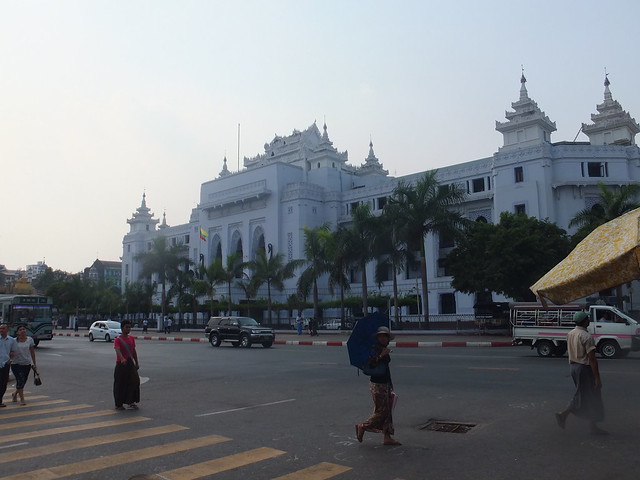 City Hall.
City Hall.
Central Telegraph Office
Built between 1913 and 1917. By 2000, it had lost most of its original roles. It is owned by the Ministry of Communications, Posts and Telgraphs and I believe the ground floor now houses stalls selling mobile phones.
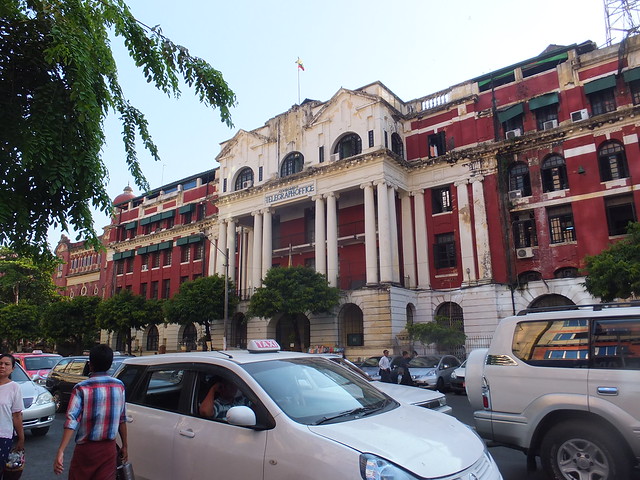 Central Telegraph Office.
Central Telegraph Office.
High Court
This 'archetypal colonial administrative building' was built between 1905 and 1911 and remains in use, although the Supreme Court has moved to Naypyitaw.
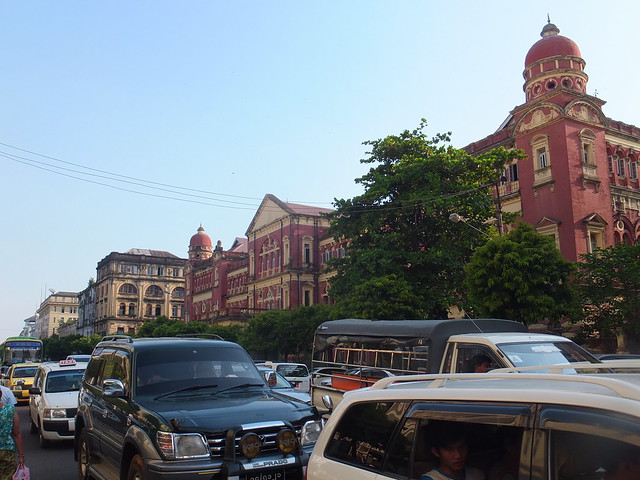 Rear elevation of High Court.
Rear elevation of High Court.
Internal Revenue Department
This building was commissioned by Surti Indian Traders from the port of Rander (hence the name 'Rander House'). It was built in 1932 and, after serving various roles, in now used by Inland Revenue, with apartments in the upper floors.
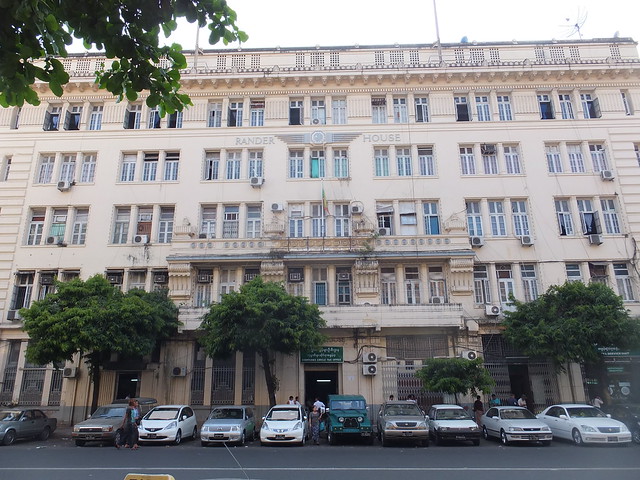 'Rander House', now the Internal Revenue Department.
'Rander House', now the Internal Revenue Department.
Meeting Friends
I was back at the hotel in plenty of time for my visitors Doctor Hla Tun and Captain Myo Lwin. They declined the offer of a meal so, instead, we had soft drinks in the Bar. Soon, it was time to say 'goodbye' to my friends - I was leaving Myanmar early the next morning by air for Doha in Qatar.
Books
[reference 1] '30 Heritage Buildings of Yangon', published by Association of Myanmar Architects in association with Serindia Publications Inc (ISBN 978-1-932476-63-7 Softcover).
My Pictures
Yangon (Rangoon).
(Pictures from March 2008, September 2008, September 2009, September 2012)
Yangon (2013).
Around Yangon, 2014.
Strand Hotel, Yangon.
Yangon's Railways
More
Next Post describing this trip.
 "...attractive stone-built houses meandering down the hill..."
"...attractive stone-built houses meandering down the hill..."



 BAe System's covered shipbuilding hall at the end of Devonshire Dock, with the Shiplift visible outside the doors.
BAe System's covered shipbuilding hall at the end of Devonshire Dock, with the Shiplift visible outside the doors.
 Green fields, cattle grazing ... and windfarms.
Green fields, cattle grazing ... and windfarms.
 Beach Houses near Sellafield.
Beach Houses near Sellafield.
 St. Bees School.
St. Bees School.














































